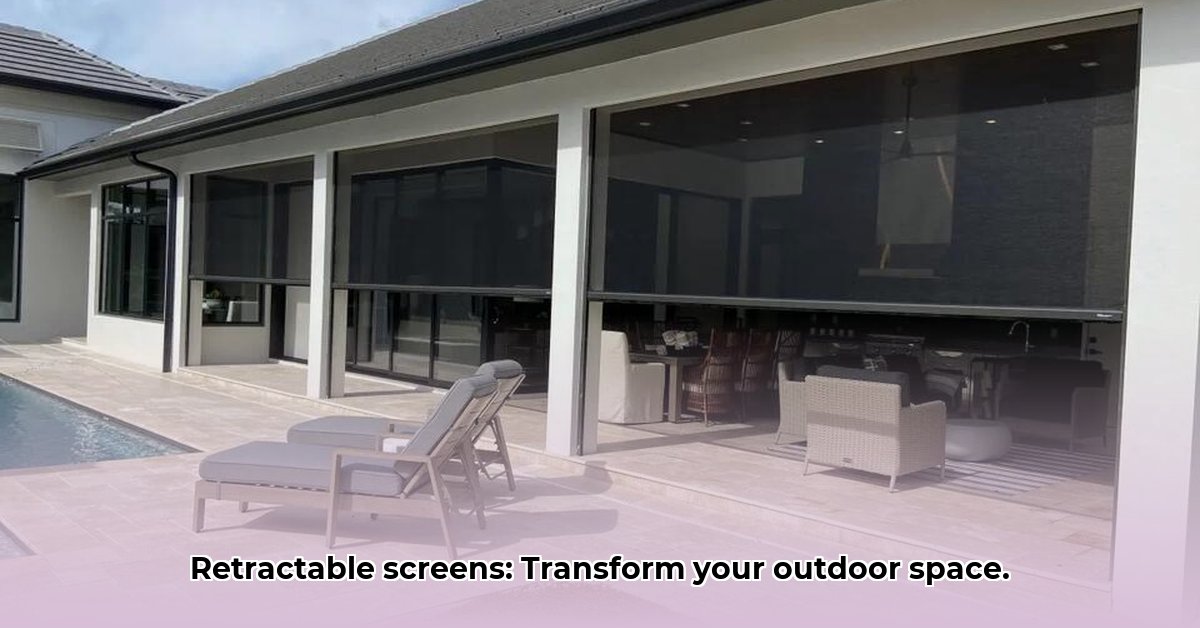Picture this: a perfect summer evening, the smell of barbecue filling the air, and your family relaxing on the deck – completely bug-free and comfortably shaded from the sun. Retractable deck screens make this dream a reality. These systems offer a fantastic way to expand your living space and enjoy the outdoors regardless of weather or pests. For more information on porch retractable screens, check out this helpful guide. This article will guide you through everything you need to know, from selecting the right type to understanding installation and maintenance, ensuring you choose the perfect retractable screens to transform your deck.
Retractable Deck Screens: Expanding Your Outdoor Living Space & Maximizing Enjoyment
Imagine a beautiful summer evening ruined by pesky mosquitoes or a sudden downpour sending everyone indoors. Retractable deck screens offer a solution by transforming your deck into a true outdoor oasis, effectively managing weather conditions and unwanted guests. What factors should you consider when selecting the perfect system to enhance enjoyment and transform your outdoor space?
Choosing the Right Retractable Screen System: Manual vs. Motorized
The world of retractable deck screens offers a range of options, each with unique advantages and disadvantages. To simplify your decision-making process, let’s explore the key considerations.
Budget is a primary factor. Motorized systems, operated via remote or smartphone apps, are generally more expensive than manual systems, but their ease of use can make the investment worthwhile. Consider how often you intend to use the screens and whether the added convenience justifies the higher price. Semi-motorized options might offer an appealing middle ground.
Next, determine the kind of protection you require. Are you primarily concerned with insects, direct sunlight, or privacy? Fine-mesh screens excel at keeping bugs out while allowing airflow. Heavier fabrics offer greater shade and privacy but may reduce air circulation. For example, privacy screens can significantly decrease visibility from neighbors, creating a more secluded outdoor experience. Some screens even offer UV protection, safeguarding your family from harmful sun rays.
Here’s a simple comparison illustrating the key differences between manual and motorized systems:
| Feature | Manual System | Motorized System |
|---|---|---|
| Cost | Generally lower | Generally higher |
| Convenience | Requires manual operation | Effortless operation; remote or app controlled |
| Maintenance | Minimal; occasional cleaning | Slightly more involved; ensure smooth operation |
| Durability | Durable, with quality materials | Durable, with quality materials |
| Power Source | None required | Requires electrical outlet or battery |
Installation and Maintenance: Ensuring a Smooth Transition and Long-Term Performance
Installing retractable screens involves careful assembly, with some systems being more straightforward than others. Smaller systems might be suitable for DIY installation by homeowners, while larger, more complex systems should be handled by professionals. Always consult the manufacturer’s instructions before beginning any installation, regardless of your confidence level. Professional installation often includes a warranty, ensuring any issues are promptly addressed.
Regular maintenance is essential for keeping your screens in excellent condition. Think of it as a small investment in their long-term performance. Simple yearly cleaning, inspection for wear and tear, and lubrication of moving parts can significantly extend their lifespan. Use a mild detergent and soft brush to clean the screens, removing any dirt or debris that may accumulate.
Factors to Consider Before You Buy: Ensuring the Right Fit
Before making a purchase, consider these essential factors to ensure you are making the best decision:
- Accurate Measurements: Measure your deck precisely. Incorrect measurements can lead to ill-fitting screens and additional costs. Professional measurements are advisable if you’re unsure. Consider measuring at multiple points, as decks may not always be perfectly square.
- Aesthetic Appeal: Ensure your retractable screens complement your deck and home’s style. Select colors and materials that seamlessly blend with the existing design. Consider the screen housing as well, ensuring it integrates well with your deck’s architecture.
- Weather Resistance: Choose durable materials designed to withstand sun, rain, and wind. Look for screens with UV protection and wind resistance ratings. Refer to the manufacturer’s warranty for added peace of mind.
- Maintenance Commitment: Be realistic about the amount of maintenance you’re willing to perform. A low-maintenance system may be preferable if you have limited time. Consider materials that are easy to clean and resistant to mildew.
- Local Building Codes: Check local building codes and regulations before installing retractable screens to ensure compliance. Some areas may have restrictions on screen size or placement.
Investing in retractable screens goes beyond just keeping pests away; it enhances your overall enjoyment of your outdoor space. It creates a comfortable, versatile area for relaxation and entertainment. Careful consideration of budgetary needs, lifestyle, and aesthetic preferences will result in a significant boost to both your home’s value and your quality of life.
How to Choose the Most Durable Retractable Screen Material for Outdoor Patios
Key Takeaways:
- Retractable screens enhance outdoor living spaces by improving comfort.
- Material choice significantly impacts screen durability and longevity.
- Balance your budget with needed screen features and maintenance efforts.
- Professional installation ensures optimal screen setup and performance.
- Consider warranties and customer reviews before making a purchase.
Understanding Your Needs: Defining Your Priorities
Before exploring materials, determine what you need most from your retractable screens. Complete sun protection? Bug-free evenings? Privacy from neighbors? Resistance to pet damage? Your answers will guide your material selection. Different materials will excel in providing different types of protection.
Exploring Retractable Screen Materials: Understanding Options
Several materials are commonly used in retractable screens for patios, each offering its own benefits. Let’s examine the key features of each.
1. Fiberglass:
- Pros: Strong, lightweight, and relatively inexpensive, fiberglass offers good resistance to tears and punctures. It also is easy to clean.
- Cons: Fiberglass can degrade over time with prolonged UV ray exposure and doesn’t provide the same sun protection as other materials. It can also stretch or sag over time, requiring occasional adjustments.
2. Solar Shade Fabric:
- Pros: Woven fabric blocks sunlight while still allowing airflow. Treated to resist UV damage, solar screens are stylish and come in various colors. They can also help reduce glare and heat buildup on your patio.
- Cons: Generally more expensive than fiberglass, solar shade fabrics’ durability can vary based on fabric type and construction. Some fabrics may be more prone to fading or staining.
3. Aluminum:
- Pros: Aluminum is incredibly durable and resistant to corrosion, providing superior protection from the elements. It also offers excellent privacy. It’s a good choice for coastal areas or environments with high humidity.
- Cons: More costly and heavier than other options, aluminum might require a more robust installation setup. It can also be more difficult to repair if damaged.
4. Vinyl-Coated Polyester:
- Pros: This mesh is strong and flexible, an affordable alternative to other durable options. It’s also resistant to mildew and fading, making it a good choice for humid climates.
- Cons: With time, the vinyl coating can wear, affecting its UV protection and weakening its structure. It may also be more prone to stretching or tearing than other materials.
5. Pet-Resistant Screening:
- Pros: Designed to withstand damage from pets, this heavy-duty screening is made from durable materials like vinyl-coated polyester or steel mesh. It’s ideal for pet owners who want to keep their screens intact.
- Cons: Pet-resistant screening can be more expensive than standard options. It may also reduce airflow slightly due to its tighter weave.
How to Choose the Most Durable Retractable Screen Material: Factors to Weigh
Choosing the most durable material for how to choose the most durable retractable screen material for outdoor patios involves carefully weighing each option’s pros and cons.
- Your Budget: Fiberglass is the most budget-friendly option. Aluminum and pet-resistant screening are generally the most expensive.
- Your Climate: In harsh climates, aluminum or high-quality solar shade fabric are better choices. Consider factors like sun exposure, humidity, and wind.
- Your Priorities: For bug protection, fiberglass or vinyl-coated polyester work well; for sun protection, solar shade fabric is better; for privacy, aluminum works best; for pet resistance, choose pet-resistant screening.
- Maintenance: All materials require some cleaning. Follow manufacturer cleaning instructions to extend screen life. Avoid using harsh chemicals or abrasive cleaners.
Installation and Maintenance: Ensuring Lasting Performance
Professional installation is usually recommended for optimal performance and longevity. Proper installation ensures screens function flawlessly and resist wind damage. With proper installation and regular maintenance, the screens can last for many years.
Regular maintenance extends the lifespan of your retractable screens. Maintain them by cleaning them regularly and inspecting them for damage. Repair any tears or holes promptly to prevent further damage.
Table Summarizing Material Choices:
| Material | Durability | Sun Protection | Insect Protection | Privacy | Cost | Maintenance | Best For |
|---|---|---|---|---|---|---|---|
| Fiberglass | Moderate | Moderate | Good | Low | Low | Low | Budget-conscious homeowners |
| Solar Shade Fabric | High | High | Moderate | Medium | Medium | Moderate | Sun protection and style |
| Aluminum | Very High | High | Excellent | High | High |
- Glass Backsplash: Ideas For a Stylish Kitchen Update - December 2, 2025
- Glass On Tile: A Stylish Kitchen Backsplash Option - December 1, 2025
- Glass Tiles for Kitchen: Style and Durability Tips - November 30, 2025










